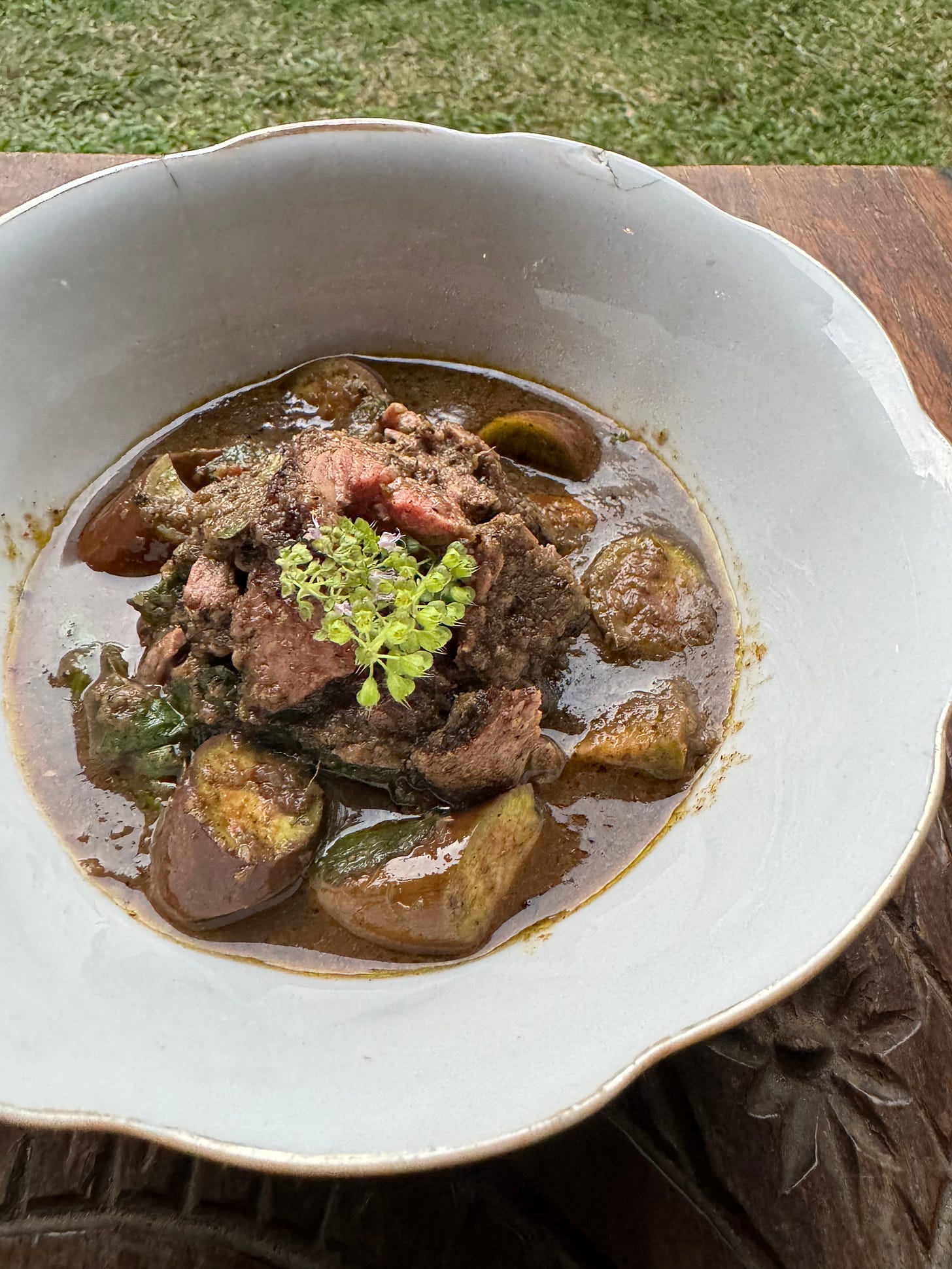Jungle curries are tantalising. They excite, tease, hurt, and impress. They are also simple dishes, both in terms of their ingredients and their preparation, which is why I am surprised that they haven’t gained much popularity among home cooks and food enthusiasts.
Perhaps they are still perceived as relatively obscure due to strange-sounding ingredients like fingerroot or green peppercorns or onerous because of unusual instructions like making a secondary curry paste. Or maybe it’s because a lot of online recipes for this dish tend to underrepresent it, offering mediocre versions of something that can be truly great and impressive.
Whatever the case, I hope this post may encourage some people to make this type of dish. In it, I’ll cover some information about the class of dishes recognised as jungle curries before walking through a straightforward but delicious recipe I’ve come up with for a simple jungle curry featuring pan-fried chicken thigh.
Jungle curries - the dish
Jungle curry, or gaeng pa in Thai, originates from the forested areas of Thailand. Whilst there is a high degree of variation amongst jungle curries from different regions (and cooks), it is safe to say that there are a few common characteristics. Consistently, these curries employ a very spicy curry paste made from a liberal amount of fresh (as opposed to dry) hot chillies and other aromatics like galangal, lemongrass, shallot and garlic.
They use water or stock as the moistening liquid (as opposed to coconut cream or milk). Because of their forested origins, they tend to be abundant in local vegetables and herbs and make use of a local protein at hand, be it fish, frog, river snails, wild boar, pork, chicken or something else. Preparing and cooking the protein is often simple, requiring little more than dropping the raw ingredients into the bubbling curry to be boiled until done.
To add to the above, jungle curries tend to be ‘thin’ and have a soup-like consistency. And again, harking back to their rural, primitive origins, they don’t contain the foreign dried spices (e.g cumin, coriander seed, etc) that are found in the aristocratic and or foreign curries popular within the broader cuisine (such as yellow curry/gaeng garee, red curry/gaengped, mussaman etc.),

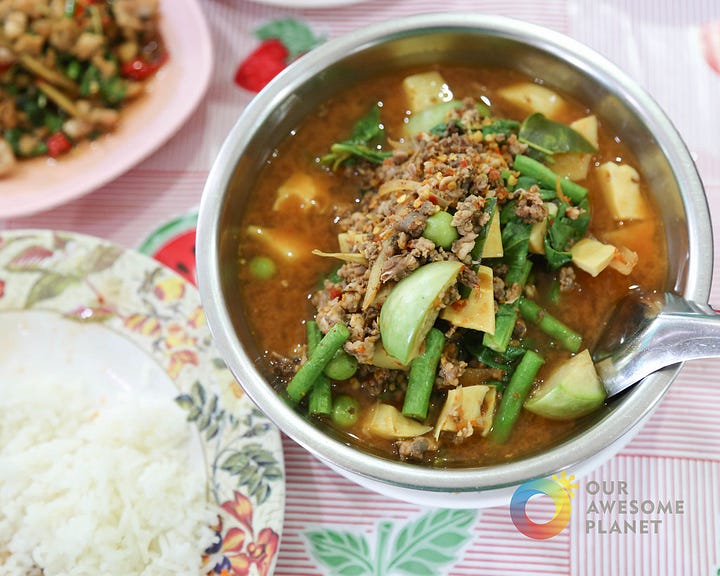
My experience
Whilst, per the above, jungle curries are often thin and soup-like, contain lots of assorted vegetables, and employ simple protein preparations, in my travels/life, I have found a few jungle curries that deviate slightly from the norm in that they are a little thicker, less soup-like, a little less rustic, and contain more deliberate vegetable inclusions (rather than the customary assortment of whatever is on hand) or no vegetables at all.
The first of these jungle curries is one from the northern Thai city of Lampang. It features a fiery hot paste, freshwater fish, a single herb (pak chee farang), and nutty fried shallots. Admittedly, I’ve never tried it at the source, but its recipe appears in David Thompson’s Thai Food, and I have made it many times to good effect.
The second of these curries, gaeng pa yaay yai, hails from Petchaburi province in central Thailand. It similarly features an incendiary hot curry paste imbued with two types of local peppercorn; the protein is beef and grilled over charcoal, and unusually, the curry is thickened with the starchy water left over from washing rice. I was taught this curry by Ying, a local of Koh Samui who, along with her partner, Daniel, run Somrom space - a fantastic culinary program highlighting Thai food, traditional cooking techniques and the cultural forces that shape the cuisine.
I liked this curry so much that I featured it as the final dish at my last pop up with my friend Andy Beynon. It was a hit amongst the diners that day, almost everyone I spoke to lauded it which was nice.
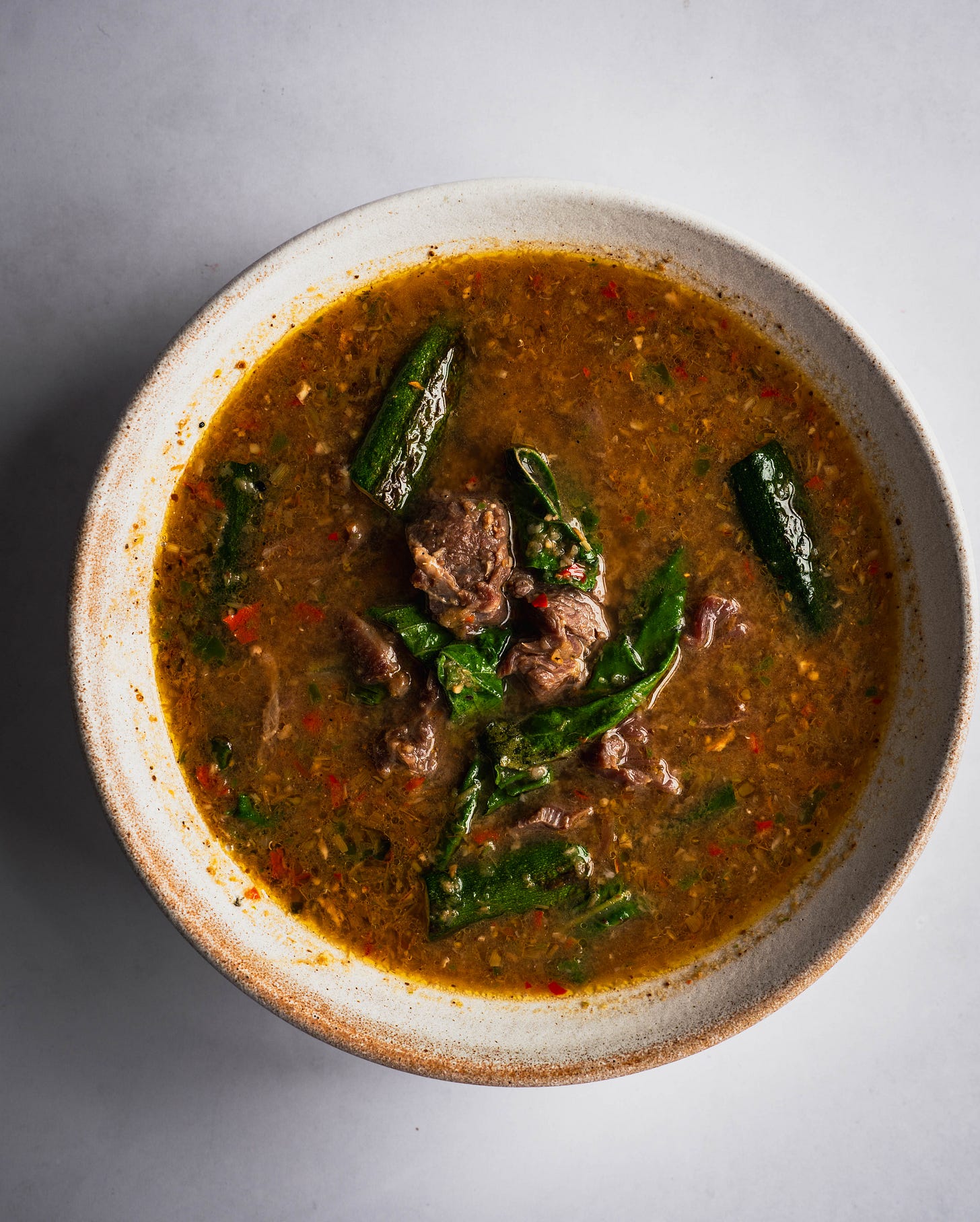
Today’s dish - jungle curry of chicken thigh
Not long ago, I was, as you do, thinking about these small variances in jungle curry preparations and it struck me that my preferences - i.e. less rustic, less soup-like, less vegetables1, and a more refined approach to the cooking of the protein, are probably a product of my context (i.e Westerner living in London; frequently dining out; accustomed to a certain style of cooking) and are therefore potentially shared by a lot of people that read this newsletter.
Through that lens, I wanted to create a simple recipe for a jungle curry that incorporates these elements whilst being relatively straightforward - something one could whip up without too much hassle.
The dish, the recipe of which I’ve shared below, is the end result. It features a fairly standard jungle curry paste, brined and therefore very, very juicy pan-fried chicken thigh, fried shallots and coriander. It is, really, really tasty. And extremely spicy2. So without further ado, have a geez below.
Recipe
The below recipe is for 2 ppl. As I did in my last post, I’ve provided two methodology walk throughs - a detailed one with photos and an abbreviated one.
Brine for chicken
300ml water
30g salt
2 tbs soy sauce
Curry paste
0.5 tsp salt
10 green Thai chillies or birdseye chillies (about 20 grams)3
2.5 tbs chopped lemongrass
1 tbs chopped galangal
1 tsp chopped lime peel
2 coriander roots4
4 cloves of chopped garlic
6 tbs chopped shallot
1 tsp shrimp paste
Fried shallot
5 tbs chopped shallot5
A little oil for frying
Rest of the curry
2 boneless chicken thighs, skin on
All of the curry paste (which should be about 4 tbs)
1/4 cup loosely chopped coriander6
250ml chicken stock
1 tbs fish sauce
1 tsp sugar
A little oil or lard to fry the paste in, about 2-3 tbs
Methodology - the long version
Brine the chicken
Dissolve 30g of salt into 300ml of water, then add the two tablespoons of soy sauce. In a container, place the chicken thighs and cover with the brine. Make sure the brine covers the chicken. If it doesn’t, try a different container. If you don’t have a different container, make more brine using the ratio above (i.e 1:10:2 salt/water/soy) until you have enough to cover the thighs. Leave for a minimum of 1 hour. Four hours or overnight also works well.
Make the curry paste
Pound your ingredients into a fine paste in a mortar and pestle. Do this by chopping your curry paste ingredients finely (except for shrimp paste) then adding them all to the mortar (except again for the shrimp paste) and pounding them until a coarse paste is achieved. Then add the shrimp paste and pound further until the paste is finer. Alternatively you can use a food processor.
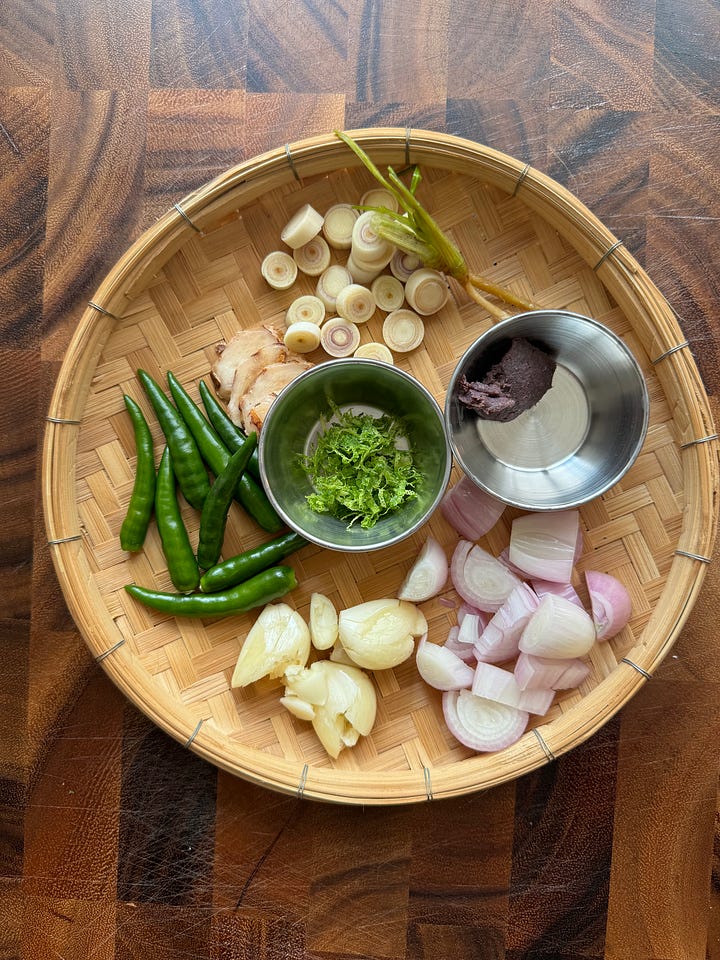
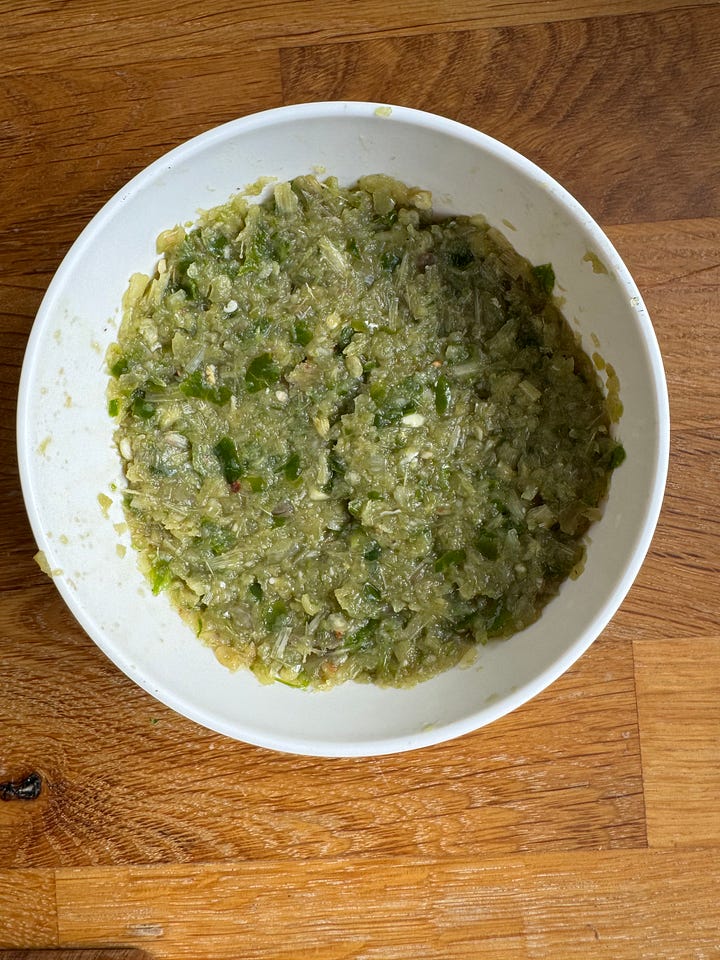
Fry shallots
In a pan add some oil and heat and add your shallots and stir until golden. Remove, then set aside. Note - you do not need to deep fry your shallots. In the images below I have as I made a big batch but simply sautéing them in a little oil until golden brown will do just fine.

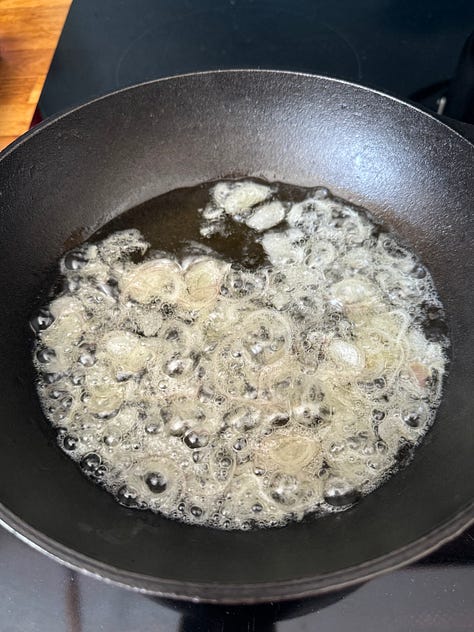

Pan fry chicken thighs
Remove the chicken thighs from the brine and pat dry with paper towel. Add some oil to a skillet and add the chicken thighs skin down and cook for a couple of minutes. I find adding a weight helps crisp up the skin7. Flip to the skinless side and cook until chicken is cooked through. Remove, and set aside to rest while you make the curry.
Make the curry
In a wok, or pan, add some oil and add about 3 tbs of oil or lard. Add the curry paste and stir fry for about 1-2 minutes. If the curry paste starts to burn add a tiny splash of stock or water. Season with sugar and fish sauce. Add chicken stock, mix everything together.
Assemble the curry
Cut the chicken thigh on a 45 degree angle into slices (a sharp knife helps). In a serving bowl add your curry broth. Add the chicken slices on top of the broth, then add the fried shallots and coriander as garnish.
Methodology - the short version
Make brine, add chicken thighs and leave to cure for 1-4 hours
Make curry paste by pounding ingredients together in a mortar and pestle, alternatively use a food processor
Fry shallots in a little oil until golden brown, set aside
Pat chicken thighs dry then pan fry skin side down until skin crispy, flip and cook until done. Remove and set aside
Add 3 tbs oil to a wok/pan, fry curry paste for a couple of minutes
Season with fish sauce and sugar, before adding chicken stock and stirring everything together
Add curry broth to a serving bowl. Cut chicken thigh into slices. Place chicken on top of broth. Garnish with fried shallots and coriander
Not because I don’t like vegetables but because too many takes away from the dish I think
If you need to reduce the spice levels you can reduce the amount of birdseye chillies and replace the removed quantity with a less-spicy green chilli variety
Green, birdseye/Thai chillies are notoriously hard to find. You can order them easily enough online. However, if you’re living in London you will find that a lot of the green grocers stock a brand of mixed red and green chillies. See here for an image. These are birdseye chillies so the green ones are perfect for this recipe,
If you can’t find coriander root, use 5 tbs of chopped coriander stem
If you have one use a mandolin as it ensures even cooking of the shallots when fried
Other herbs like holy basil or pak chee farang also work
Like a smaller sauce pan or a fahncy chefs press







